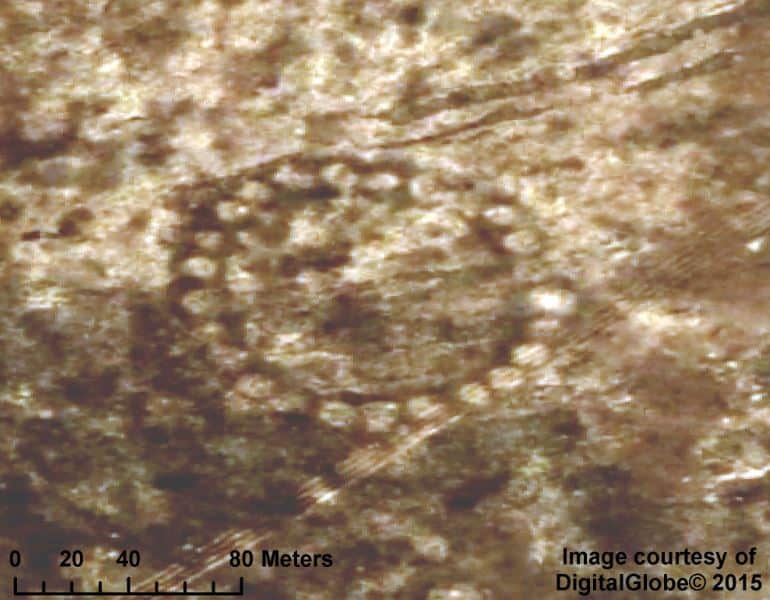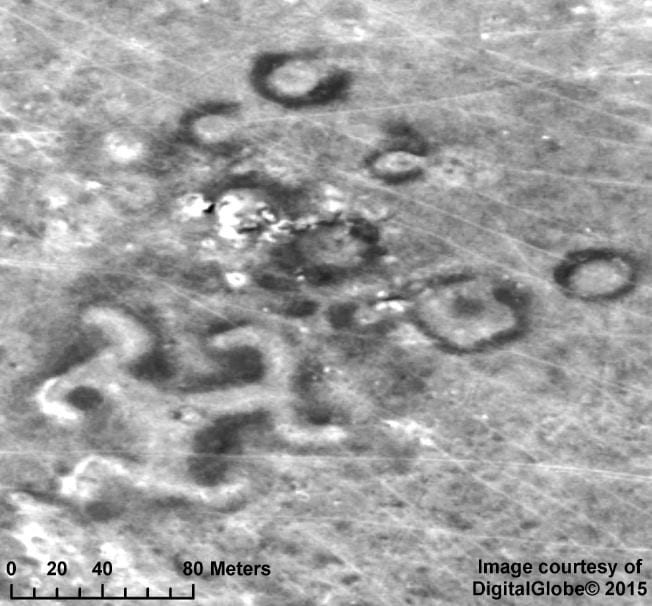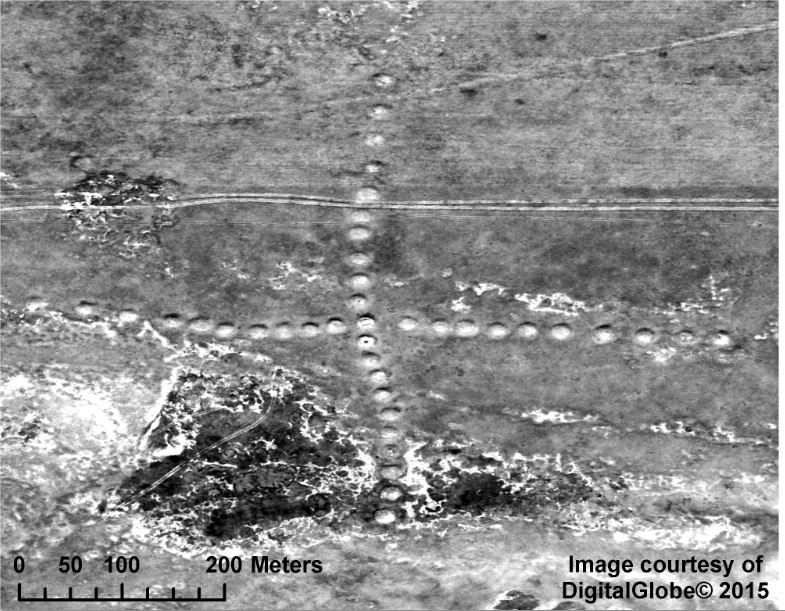NASA scientists cannot explain how some huge Kazakhstan patterns got there, what they are, how or who made them, or what they are for. The gigantic formations, believed to be about 8,000 years old, known as Steppe Geoglyphs, must have been made by humans … right?
The scientists believe that if they can solve the mystery of how these giant structures were formed, the way we currently understand early humans will change dramatically.
The whole collection consists of about 260 designs which are carved into the ground. They are made out of piles of earth, put together into shapes like rings, squares and swastika-like formations. Some of them are made of earth dug out and piled up, while others consist of stones that were placed next to each other.
Owen Jarus wrote in Live Science in September 2014 that one of the structures, a swastika, was made using timber.
The composite figures range in size from just under 90 meters in length to over 400 meters in diameter.
 A satellite photo of the Bestamskoe Ring, one of the structures in Kazakhstan. (Image: opendrive.gsfc.nasa.gov)
A satellite photo of the Bestamskoe Ring, one of the structures in Kazakhstan. (Image: opendrive.gsfc.nasa.gov)
Some of the larger formations have been given names, including Ushtogaysky (or Ushtogay) Square, Turgay triradial swastika, Ekedyn cross, Large cross Ashtasti, Koga cross, Bestamskoe Ring, Kyzyloba line, Ashutasti ring and Shili square.
First spotted on Google Earth
A Kazakh enthusiast, Dmitriy Dey, an economist, first spotted them on Google Earth in 2007. After watching a Discovery Channel program about pyramids, he decided to find out whether any such structures existed in Kazakhstan. During his search he came across the mysterious structures.
Dey suggested they were produced by the Mahandzhar culture (a Stone Age tribe) between 7,000 and 9,000 years ago.
Even though we have known about them for the past eight years, experts in Kazakhstan have not carried out any extensive studies to determine what they are.
In 2014, an archeological expedition from Kostanay University in Kazakhstan, and Vilnius University in Lithuania, examined the geoglyphs. In an email to Live Science, they wrote “As of today, we can say only one thing — the geoglyphs were built by ancient people. By whom and for what purpose, remains a mystery.”
NASA scientists have become interested in finding out exactly how they got there. The American agency responsible for the country’s civilian space program has released several images captured by satellites. This is the first time they have been photographed in an attempt to catalogue and investigate them.
 A satellite picture of the Turgai Swastika, one of the structures in Kazakhstan. (Image: opendrive.gsfc.nasa.gov)
A satellite picture of the Turgai Swastika, one of the structures in Kazakhstan. (Image: opendrive.gsfc.nasa.gov)
Once a place hunters would congregate
Several thousands of years ago, the land surrounding the symbols used to be an important destination for Stone Age humans looking for places to hunt. However, archeologists cannot see how hunter-gatherer tribes would have had the time or knowhow to dig and build the massive symbols.
In an interview with the New York Times, Persis B Clarkson, an archaeologist at the University of Winnipeg, said:
“The idea that foragers could amass the numbers of people necessary to undertake large-scale projects – like creating the Kazakhstan geoglyphs – has caused archaeologists to deeply rethink the nature and timing of sophisticated large-scale human organization as one that predates settled and civilized societies.”
 A NASA satellite image of the Ushtogaysky Square, located in Kazakhstan. (Image: opendrive.gsfc.nasa.gov)
A NASA satellite image of the Ushtogaysky Square, located in Kazakhstan. (Image: opendrive.gsfc.nasa.gov)
Nobody knows whether the Kazakhstan geoglyphs were made for a practical purpose, or just as an early form of art. Some experts wonder whether they might have been solar observatories, like Stonehenge in England is purported to have been.
Many bizarre theories circulating online
UFO and alien enthusiasts have filled the Internet to bursting with an ever-widening range of suggestions. Perhaps it had something to do with extraterrestrial civilizations, they wonder, or the Nazis, given the swastika-like shapes some of the formations have.
 This satellite image is of the Big Ashutastinsky Cross, also one of the structures in Kazakhstan. (Image: opendrive.gsfc.nasa.gov)
This satellite image is of the Big Ashutastinsky Cross, also one of the structures in Kazakhstan. (Image: opendrive.gsfc.nasa.gov)
The swastika was not an exclusively Nazi emblem. Called svastika in Sanskrit (the primary sacred language of Hinduism), it is considered to be a sacred and auspicious symbol in Buddhism, Hinduism and Jainism.
Video – Amazing photos of geoglyphs in Kazakhstan

